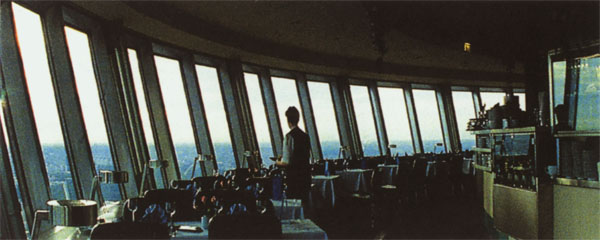Artist:
Tacita Dean (born 1965 in Canterbury, England; lives and works in Berlin, Germany).
Materials:
16-mm film, projection, color, and sound.
Description:
“Fernsehturm was created during Dean’s year-long DAAD fellowship with the Berlin Artist-in-Residence programme in anticipation of her solo exhibition, in early 2001, at Tate Britain… Dean initially visited Berlin in 1987 as a student, when a trip up the iconic television tower that dominates the east of the city, known as the Fernsehturm, had left her with colourful impressions, so it was natural that it was the first monument in that city that she filmed. Conceived by the Berlin architect Hermann Henselmann following the model of the Stuttgart Fernsehturm (the world’s first concrete television tower, constructed in the mid 1950s), the Berlin Fernsehturm was built between 1965 and 1969 in Alexanderplatz. From here it overlooks the city skyline—a steel-clad sphere encircled by a double row of windows and containing a revolving restaurant, mounted on a concrete needle that extends above the sphere in a tall red and white striped television aerial. When it was erected in the 1960s the tower was intended by the city’s Socialist Unity Party to be a monument to the future of the German Democratic Republic.”
—Elizabeth Manchester, “Tacita Dean: Fernsehturm,” Tate, last modified September 2009.
“The Fernsehturm Tower was built between 1965 and 1969, in the former GDR. It is a revolving sphere in space that somehow retains something of the optimism of the 1960s. You can see it from anywhere in Berlin, and from the aeroplane when you land. It’s a real landmark. It always changes with the weather: when the sun shines it catches the light and projects a huge cross, called the Pope’s Revenge—ironically pointing towards the west—and when the weather is cloudy, it becomes a stem that disappears into the sky. Inside there is a revolving restaurant, which was sped up after the fall of the Wall: it used to take an hour to do a full rotation of the view, and now it takes half an hour. It’s a beautiful allegory of progress—the speeding-up for capitalism.”
—Tacita Dean, “Wonders and Blunders,” The Guardian, May 30, 2005.


